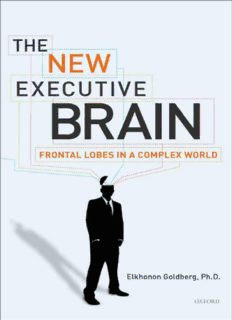
The New Executive Brain: Frontal Lobes in a Complex World PDF
Preview The New Executive Brain: Frontal Lobes in a Complex World
THE NEW EXECUTIVE BRAIN Also by Elkhonon Goldberg The Executive Brain: Frontal Lobes and the Civilized Mind The Wisdom Paradox: How Your Mind Can Grow Stronger As Your Brain Grows Older THE NEW EXECUTIVE BRAIN Frontal Lobes in a Complex World Elkhonon Goldberg OXFORD UNIVERSITY PRESS Oxford University Press, Inc., publishes works that further Oxford University’s objective of excellence in research, scholarship, and education. Oxford New York Auckland Cape Town Dar es Salaam Hong Kong Karachi Kuala Lumpur Madrid Melbourne Mexico City Nairobi New Delhi Shanghai Taipei Toronto With offices in Argentina Austria Brazil Chile Czech Republic France Greece Guatemala Hungary Italy Japan Poland Portugal Singapore South Korea Switzerland Thailand Turkey Ukraine Vietnam Copyright © 2009 by Elkhonon Goldberg. Published by Oxford University Press, Inc. 198 Madison Avenue, New York, New York 10016 www.oup.com Oxford is a registered trademark of Oxford University Press All rights reserved. No part of this publication may be reproduced, stored in a retrieval system, or transmitted, in any form or by any means, electronic, mechanical, photocopying, recording, or otherwise, without the prior permission of Oxford University Press. Library of Congress Cataloging-in-Publication Data Goldberg, Elkhonon. The new executive brain : frontal lobes in a complex world / Elkhonon Goldberg. p. ; cm. Includes bibliographical references and index. ISBN: 978–0–19–532940–7 1. Frontal lobes. 2. Neuropsychology. I. Title. [DNLM: 1. Frontal Lobe—physiology. 2. Brain Diseases—physiopathology. 3. Mental Processes—physiology. WL 307 G618n 2009] QP382.F7G653 2009 612.8′25—dc22 2009006253 9 8 7 6 5 4 3 2 1 Printed in the United States of America on acid-free paper To my mentor and friend Alexandr Luria Acknowledgments My thanks go to Oxford University Press for ensuring the success of The Executive Brain and thus laying the ground for The New Executive Brain. My editor Craig Panner, assistant editor David D’Addona, and production editor Lynda Crawford, as well as the copy editor Jerri Hurlbutt, were all superb with their combination of a soft touch and a firm hand at every stage of my work on The New Executive Brain. Dmitri Bougakov has again been most helpful with numerous technical aspects of the book. Michael Carlisle was a source of wise advice on numerous issues, including the book’s title. Nicholas (Colly) Myers kindly agreed to critically review the manuscript and his comments and insights are greatly appreciated. Richard Gallini provided the artwork for the book with patience and insight. Jeffrey Donaldson provided invaluable help with references. Larry Abbott, Sigurd Ackerman, Robert Bilder, John Caronna, Michael Cole, Colby Collier, Anna DiStefano, John Fawcett, Cecilia Gamburg, John Garland, Brian King, Lisa King, Sergey Knazev, Alex Martin, Allan Mirsky, Ralph Nixon, Peter Palmer, Kenneth Podell, Silvana Riggio, and Daniel Sodickson have provided valuable input. My dog Brit has been my constant and most agreeable companion throughout the process, never judgmental and never demanding, unless hungry. I am particularly grateful to Vladimir and Kevin for giving me an opportunity to learn from their conditions; to those called Toby and Charlie as well as L. H. and S.F. for sharing their life stories and allowing me to describe them in this book; to Kevin’s father for allowing me to write about his son; and to Robert Iacono for sharing his experience with cingulotomy. I dedicate this book, as one before, to the memory of my mentor and friend Alexandr Romanovich Luria. E. G. New York, N.Y. Contents Foreword 1. Introduction 2. An End and a Beginning: A Dedication 3. The Brain’s Chief Executive: The Frontal Lobes at a Glance The Many Faces of Leadership The Executive Lobe 4. Architecture of the Brain: A Primer The Microscopic View The Macroscopic View The Command Post and Its Connections 5. The Orchestra’s Front Row: The Cortex Sounds and Players Noah’s Predicament and the Landscapes of the Brain Neuropaganism: Module Madness Cognitive Gradients and Cognitive Hierarchies A Thing Is a Thing A Word to a Thing Cortical Gradients in the Frontal Lobes Autonomy and Control in the Brain 6. Novelty, Routines, and Cerebral Hemispheres A False Start The New Paradigm The Evidence Lessons for Clinicians Agnosias and Hemispheres Executive Deficit and Hemispheres 7. The Conductor: A Closer Look at the Frontal Lobes Novelty and the Frontal Lobes Working Memory—or Working with Memory? Freedom of Choice, Ambiguity, and the Frontal Lobes Neuroeverything 8. Emotion and Cognition The Emotional Frontal Lobes Emotions, Novelty, and Cerebral Hemispheres 9. Different Lobes for Different Folks: Decision-Making Styles and the Frontal Lobes The Neuropsychology of Individual Differences Male and Female Cognitive Styles Frontal Lobes, Hemispheres, and Cognitive Styles Cognitive Styles and Brain Wiring Rebels in Small Proportion: Handedness and Novelty Seeking Executive Talents: The S Factor and the Theory of Mind 10. When the Leader Is Wounded The Fragile Frontal Lobes Frontal Lobe Syndromes Drive and Newtonian Bodies: A Dorsolateral Case Study Plans and “Memories of the Future” Rigidity of Mind Mind Blindspot: Anosognosia 11. Social Maturity, Morality, Law, and the Frontal Lobes Orbitofrontal “Pseudopsychopathic” Syndrome and the Loss of Self- Control Social Maturity and the Frontal Lobes Biological Maturation and Social Maturity: A Historical Puzzle Frontal Lobe Damage and Criminal Behavior The Hapless Robber Frontal Lobe Damage and the Public Blindspot 12. Fateful Disconnections The Fallen Horseman: A Case Study Schizophrenia: A Connection That Was Never Made Head Trauma: A Broken Connection
Description: